
Reclaiming Annandale's Historic Town Center
By: M. Callahan & J. Levine
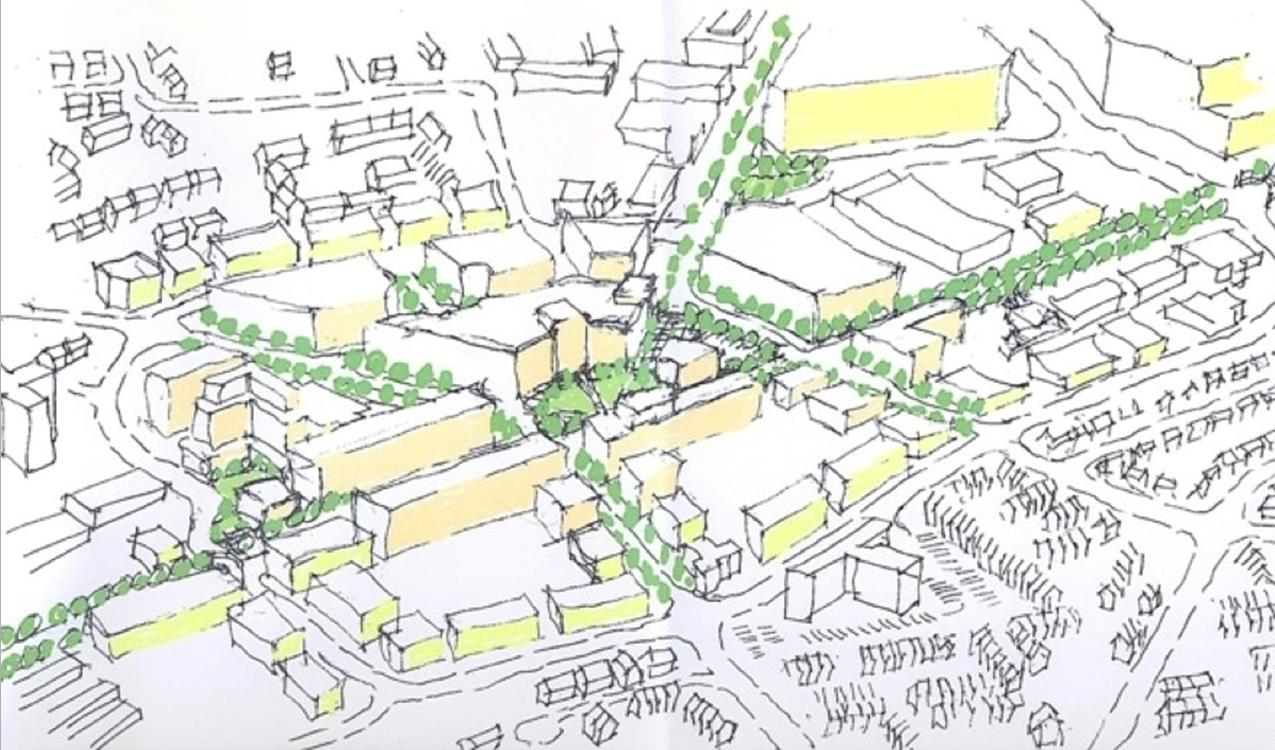 How is an established community revitalized? Many urban planners begin by creating a town center and developing outward from this central point. Unlike two recently built projects at Penrose Square in Arlington and the Mosaic Center at Merrifield, where the centers are not in historically inevitable locations, Annandale’s town center naturally occurs at the intersection of two important colonial roadway. This intersection is the site of the first commercial businesses in Annandale, and has been fully occupied for more than 200 years by succeeding businesses. See the following link for a story about Annandale's Original Commercial District.
How is an established community revitalized? Many urban planners begin by creating a town center and developing outward from this central point. Unlike two recently built projects at Penrose Square in Arlington and the Mosaic Center at Merrifield, where the centers are not in historically inevitable locations, Annandale’s town center naturally occurs at the intersection of two important colonial roadway. This intersection is the site of the first commercial businesses in Annandale, and has been fully occupied for more than 200 years by succeeding businesses. See the following link for a story about Annandale's Original Commercial District.
Proposing a Town Center Plaza at the intersection of Columbia Pike and Little River Turnpike enhances the historical heart of Annandale, and could be a catalyst in the future development of our downtown. This proposal, similar to the Annandale Demonstration Project, is community driven, with help from the School of Design at the Annandale campus of Westwood College. It is important to emphasis that this is not an official plan, but a suggestion to help kick-start the much needed, and highly desired redevelopment of Annandale’s Central Business District.
The creation of a true town center is often the catalyst needed to encourage redesign and redevelopment of the surrounding area. Once one area is recreated, a bridging effect often occurs. Properties next door and across the street see the impact and wish to bridge, or tie, their future fortunes to the new development. Higher end boutiques and eateries are looking for new space in vibrant communities, but they prefer new construction or new reconstruction, at a minimum. Residents frequently complain about the lack of both variety and quality of retail and dining options in Annandale. Until new construction or complete reconstruction takes place, and more office space is put under lease, that variety is unlikely to develop. A key component of the Plaza Proposal is the incorporation of urban design quick-fixes, which are significant physical enhancement that can be implemented economically and quickly.
Historical Context: In early Colonial times, Northern Virginia was predominantly rural, raw, and wild. Annandale was settled in the late 17th century by planters relocating from the Tidewater region, and newly arrived Europeans off ships that docked at the Port of Alexandria. Annandale was included in the Northern Neck Proprietary owned by Lord Thomas Fairfax of Cameron, and inherited in the 1630’s through his maternal Culpeper family. Lord Fairfax employed Robert “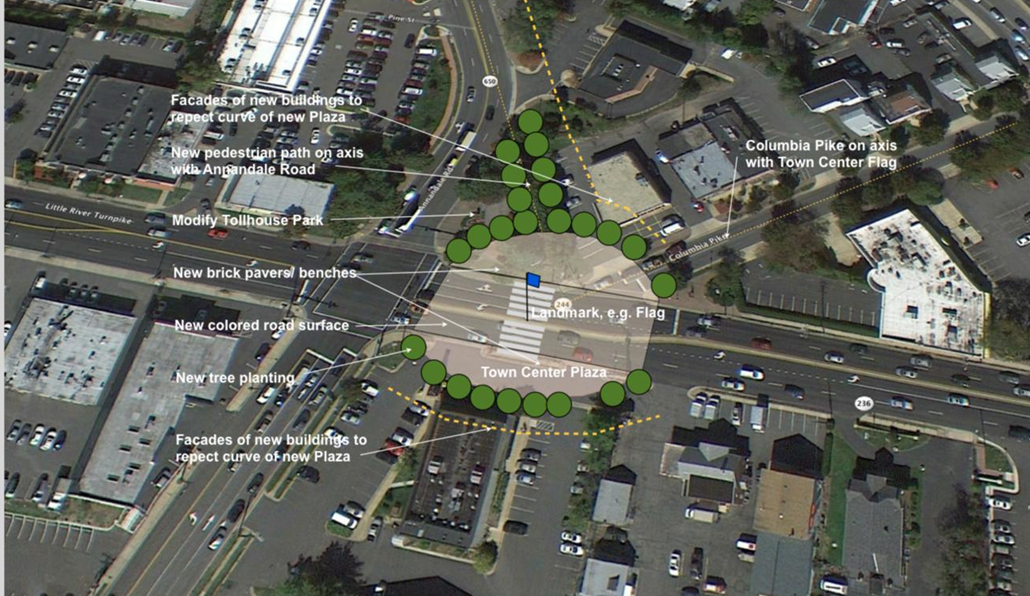 King” Carter as his first resident land agent followed by his cousin, Colonel William Fairfax, who built one of the most beautiful early estate homes, Belvoir. Lord Fairfax briefly stayed at Belvoir until settling permanently in his Shenandoah Valley manor at Greenway Court. Fairfax lands ranged from the Shenandoah to the South Branch of the Potomac Valley totaling 5,282,000 acres.
King” Carter as his first resident land agent followed by his cousin, Colonel William Fairfax, who built one of the most beautiful early estate homes, Belvoir. Lord Fairfax briefly stayed at Belvoir until settling permanently in his Shenandoah Valley manor at Greenway Court. Fairfax lands ranged from the Shenandoah to the South Branch of the Potomac Valley totaling 5,282,000 acres.
For Lord Fairfax to support his local expenses and a lavish lifestyle, and to maintain the cost of his family seat, Leeds Castle, he sold some Virginia land to local planters and collected quit rents on other parcels. In 1779, resulting from the revolutionary war, his lands were confiscated under the Virginia Act. Over the next three decades, the Jamestown government provided land grants to those who wished to homestead in Northern and Western Virginia. Many of these parcels were located on former Fairfax land. Each homesteader was required to build a home on the land, establish residency there, and plant the land within three years. Some were able to avoid the residency requirement by hiring resident land agents, but most built their home and their future on this newly acquired land.
The need then arose for the creation of highways. Planters (farmers) from as far west as the Shenandoah needed to transport their cash crops, and herd livestock to market. The trails from areas around Snickersville, and what is now Middleburg, led through gaps in the local hills to the ford on the Little River, at Aldie. It was here that the first toll road was chartered by the Virginia Assembly in 1796. It was named Little River Turnpike and ran from Aldie, VA to Alexandria with a tollhouse located every five miles. The one in Annandale was built on the southeast corner of Little River and Ravensworth Road.
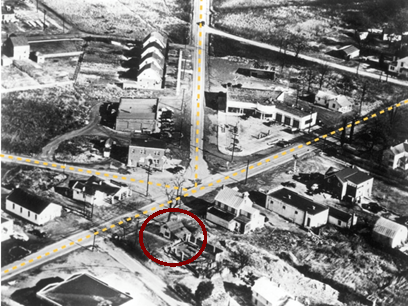 Additionally, in 1810, an Act of Congress incorporated a company to create three turnpikes out of Washington DC - one to Baltimore, one to Montgomery Courthouse and one to the Southwest; the latter being Columbia Pike. Columbia Pike provided a direct route into Washington, avoiding the detour through Alexandria. This historic crossroads became the center of the Annandale community which grew around thetoll house similar to today’s business developments found at major highway intersections. Today’s Exxon, Holiday Inn, and Cracker Barrel were yesterdays livery, traveler’s inn and general store.
Additionally, in 1810, an Act of Congress incorporated a company to create three turnpikes out of Washington DC - one to Baltimore, one to Montgomery Courthouse and one to the Southwest; the latter being Columbia Pike. Columbia Pike provided a direct route into Washington, avoiding the detour through Alexandria. This historic crossroads became the center of the Annandale community which grew around thetoll house similar to today’s business developments found at major highway intersections. Today’s Exxon, Holiday Inn, and Cracker Barrel were yesterdays livery, traveler’s inn and general store.
Why were toll roads developed? Public maintenance was inadequate due to the heavy traffic generated by wagons and carriages, and government maintenance, in the early republic, was impractical. Tolls were created simply to allow for improved roadways. At each tollhouse the road was barred by a long pole or pike stopping all rolling stock until the toll was paid. Each was supervised by a toll keeper who acted as security guard, custodian, handyman, representative and conduit to the turnpike executives.
Current Situation: Figure 3 shows a current view of the Annandale Central Business District. How do you accommodate a practical and visually identifiable town center into a limited area? Small commercial establishments and larger amorphous buildings are already established. The dramatic increase in traffic and population has created visual clutter, wider roads, and a proliferation of surface parking lots, as well as the loss of a clearly defined town center.
The historic town center at Toll House park has been recognized in the recent amendment to the Fairfax County Comprehensive Plan. However, the park’s scale, layout and landscaping should be improved to reflect its locational importance and to create an undeniable impact. In the proposal as seen on the cover of this magazine, buildings would be at a scale accepting to pedestrians and the vehicular traffic. The main facades of these buildings would face the major streets converging on the center where the original Toll House stood. (See Figure 2)
Urban Design Quick Fixes: Since most development takes a long time to reach fruition, creating immediate visual statements in an urban setting can be desireable. One example can be seen in Figure 4. The After View of this parking lot on Annandale Road at Maple Place, has been planted with clusters of trees to distract the eye from the abundance of hardscape and unimaginative architecture. Color has been added to the gable end of he building and banners have been hung along the street edges. The result is a far more pleasing appearance at very little cost or disturbance.
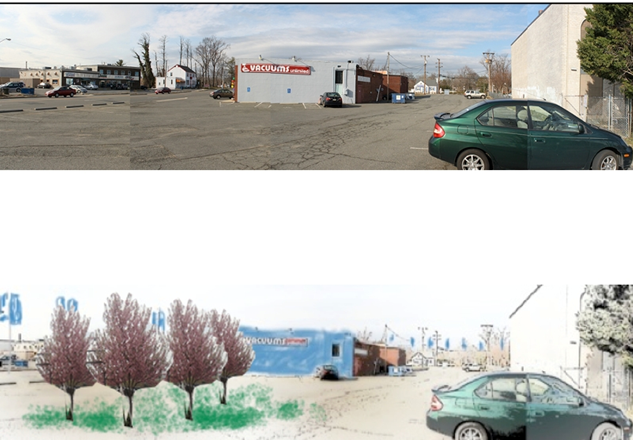 Town Center Plaza Proposal: The concept aerial view in Figure 1 indicates one approach for creating Annandale’s town center by simply respecting the historical context and using urban design quick fixes. Figure 2 provides an over head view of Annandale in about 1946 where the layout of the buildings focused, even then, on the convergence of Columbia Pike and Annandale Road. Early in Annandale’s modern age, there was limited traffic and building development beyond the boundaries of the historic town center. Now, commercial space proliferates in all directions.
Town Center Plaza Proposal: The concept aerial view in Figure 1 indicates one approach for creating Annandale’s town center by simply respecting the historical context and using urban design quick fixes. Figure 2 provides an over head view of Annandale in about 1946 where the layout of the buildings focused, even then, on the convergence of Columbia Pike and Annandale Road. Early in Annandale’s modern age, there was limited traffic and building development beyond the boundaries of the historic town center. Now, commercial space proliferates in all directions.
The goal of this Proposal is to create a visually-defined circle, spanning across Little River Turnpike, with a landmark, such as the Annandale Flag at its center. This is the exact historical intersection of Annandale Road, Little River, and Columbia Pike. The circle would be emphasized by a new colored surface onthe road, and on the surface of the pedestrian plaza. New trees would be planted at the perimeter with additional benches and possibly pieces of public art. Finally, the facades of new buildings should respect the curve of the new Plaza and serve to reinforce it. No existing buildings would be demolished. Finally, Toll House Park would be modified with a new pedestrian path centered on the original axis with Annandale Road.
This project could be implemented by working closely with the Virginia Department of Transportation and Fairfax County through elected officials and representatives; with funding through community improvement/art grants; and, eliciting community sponsorship of brick pavers, benches and trees. Additionally, since this public improvement could act as a catalyst for future development, developers would be asked for contributions.
The Annandale Town Center Plaza would make a dynamic public space, create higher revenues for surrounding businesses, provide a safer crossing over Little River Turnpike, and can be developed with the expertise of transportation and urban engineers as well as proactive community members and elected officials. Most importantly, it can be implemented quickly.
To kick start revitalization in Annandale’s CBD, it is necessary to convince developers that their considerable investment is going into a community that welcomes the redevelopment, and is willing to bind their history to a vibrant and modern future. Creating a true town center may help to send that message, while establishing a catalyst for development.
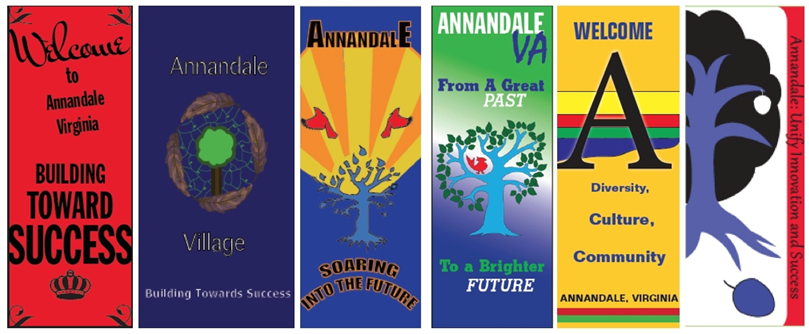
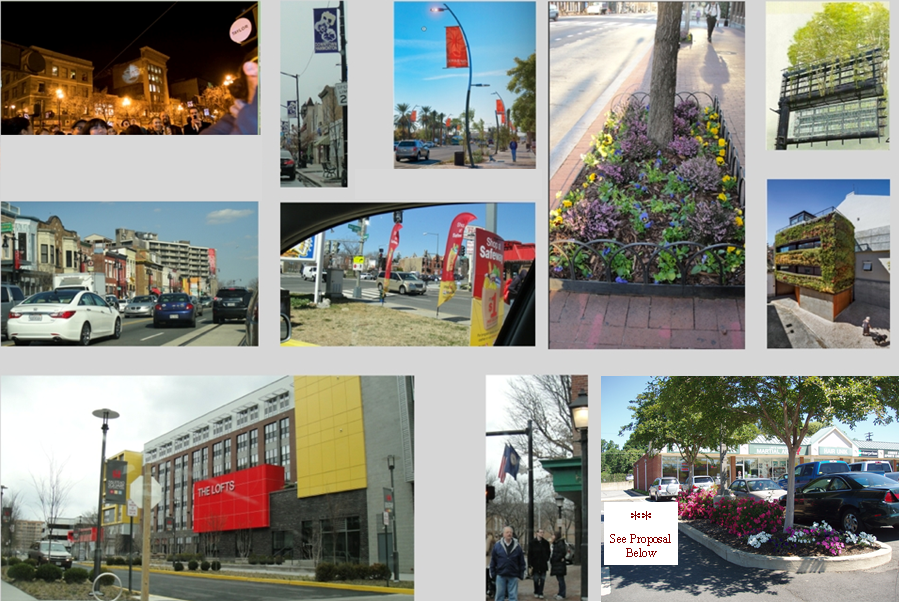
Urban Design Quick Fixes
Proposal for Commercial Property Owners: Plant pink or red carpet roses and crepe myrtle trees on your property. The trees will visually distract the eye from the ugly overhead wires, and the roses will help soften the hardscape as well as add a unified color palate to the commercial landscape. See the effect in the photo below.
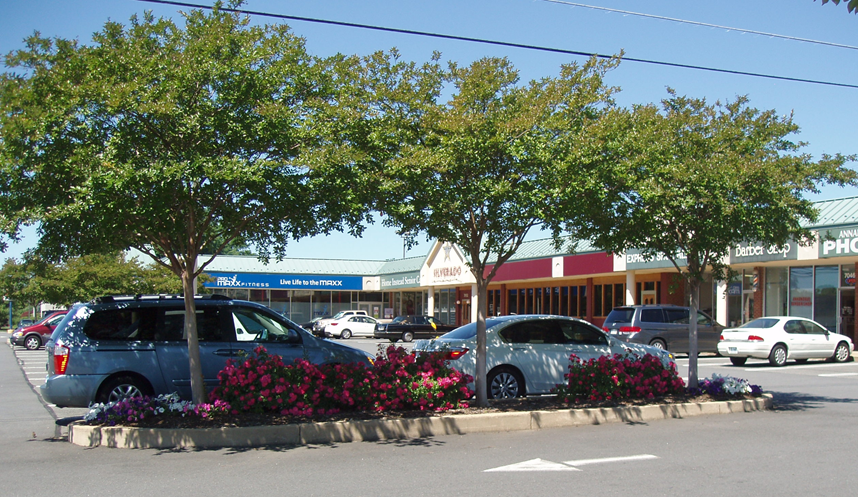 For the complete article and other articles on Revitalization or Annandale History, please see the ENDEAVOR News Magazine (July 2013) and the History and Community Revitalization sections on this website.
For the complete article and other articles on Revitalization or Annandale History, please see the ENDEAVOR News Magazine (July 2013) and the History and Community Revitalization sections on this website.
Reproduction and distribution of this article or photographs requires the written permission of The ENDEAVOR News Magazine.
(Copyright © 2012 Annandale Chamber of Commerce. All rights reserved. (Photographs & images, on this page, and on this website, are the property of the Annandale Chamber of Commerce, and are not available for use by other publications, blogs, individuals, or websites, or social media sites.)
Copyright 2012 Annandale Chamber of Commerce. All rights reserved. Privacy Policy
